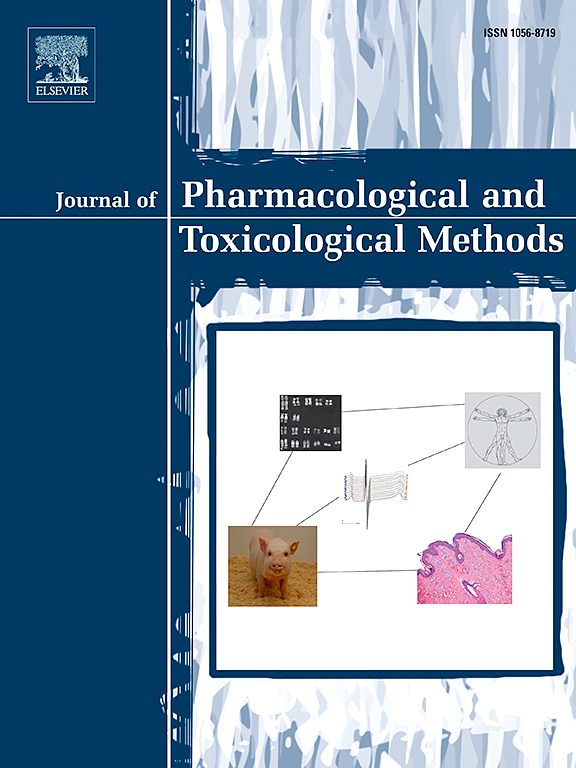用于评价可兴奋细胞结构和功能的多路细胞试验
IF 1.3
4区 医学
Q4 PHARMACOLOGY & PHARMACY
Journal of pharmacological and toxicological methods
Pub Date : 2025-05-01
DOI:10.1016/j.vascn.2025.107666
引用次数: 0
摘要
诱导多能干细胞技术的灵活性和可及性使得复杂的人类生物学能够在体外以高通量规模复制。事实上,干细胞技术的快速发展已经广泛应用于神经元和心肌细胞电生理体外模型的开发,用于药物发现和安全性的筛选应用。此外,先进的细胞制剂,如类器官,正在研究中,目的是在体外建立成熟的人类表型。为了开发和验证相关的体外神经元和心脏模型,评估神经元突触和网络的结构和功能,以及心肌细胞活力、电生理和收缩性至关重要。这项工作的目的是开发和验证一种多重结构-功能分析方法,作为体外评估神经元和心肌细胞模型的有效方法。微电极的平面网格嵌入每个孔的基底,与培养的细胞网络接口,以连续监测电生理功能和结构活力。电极检测来自细胞的原始电活动以识别功能的变化,而结构效应,如形态变化和细胞活力,则通过细胞-电极界面阻抗的变化来检测。在这里,我们使用已知的差异影响细胞结构和功能的对照化合物来表征和验证这种多重分析。对于ipsc衍生的神经元模型,所有测试的化合物(DMSO、谷氨酸、三丁基锡、离子霉素和Triton X-100)都改变了功能尖峰活性。通过阻抗测量,谷氨酸、碘霉素和三丁基锡均产生剂量和时间依赖性的活力下降,Triton X-100作为膜完整性完全丧失的阳性对照。对于心肌细胞,所有化合物(E-4031、硝苯地平、异丙肾上腺素、阿霉素和白布司他汀)都会影响电功能或收缩功能,但只有阿霉素会降低细胞活力。这些结果支持继续开发和使用人类ipsc衍生的神经元和心肌细胞检测,用于高通量药物发现和安全性评估。本文章由计算机程序翻译,如有差异,请以英文原文为准。
Multiplexed cell-based assays for evaluating the structure and function of excitable cells
The flexibility and accessibility of induced pluripotent stem cell technology has allowed complex human biology to be reproduced in vitro at high throughput scales. Indeed, rapid advances in stem cell technology have led to widespread adoption for the development of in vitro models of neuron and cardiomyocyte electrophysiology to be used in screening applications in drug discovery and safety. Furthermore, advanced cell preparations, such as organoids, are under investigation with aims toward establishing mature human phenotypes in vitro. For the development and validation of relevant in vitro neuronal and cardiac models, it is critical to evaluate the structure and function of neuronal synapses and networks, as well as cardiomyocyte viability, electrophysiology, and contractility. The objective of this work is to develop and validate a multiplexed structure-function assay as an efficient approach for evaluating neuronal and cardiomyocyte models in vitro. A planar grid of microelectrodes embedded in the substrate of each well interfaces with cultured cellular networks to continuously monitor both electrophysiological function and structural viability. The electrodes detect the raw electrical activity from the cells to identify changes in function, while structural effects, such as morphological changes and cell viability, are detected as changes in impedance at the cell-electrode interface. Here, we characterized and validated this multiplexed assay using known control compounds that differentially affected cell structure and function. For iPSC-derived neuronal models, all compounds tested (DMSO, glutamate, tributyltin, ionomycin, and Triton X-100) altered functional spiking activity. Glutamate, ionomycin, and tributyltin all produced a dose- and time-dependent decrease in viability, as measured via impedance, with Triton X-100 serving as the positive control for complete loss of membrane integrity. For cardiomyocytes, all compounds (E-4031, nifedipine, isoproterenol, doxorubicin, and blebbistatin) affected aspects of electrical or contractile function, but only doxorubicin decreased cell viability. These results support the continued development and use of human iPSC-derived neuronal and cardiomyocyte assays for high throughput drug discovery and safety assessment.
求助全文
通过发布文献求助,成功后即可免费获取论文全文。
去求助
来源期刊

Journal of pharmacological and toxicological methods
PHARMACOLOGY & PHARMACY-TOXICOLOGY
CiteScore
3.60
自引率
10.50%
发文量
56
审稿时长
26 days
期刊介绍:
Journal of Pharmacological and Toxicological Methods publishes original articles on current methods of investigation used in pharmacology and toxicology. Pharmacology and toxicology are defined in the broadest sense, referring to actions of drugs and chemicals on all living systems. With its international editorial board and noted contributors, Journal of Pharmacological and Toxicological Methods is the leading journal devoted exclusively to experimental procedures used by pharmacologists and toxicologists.
 求助内容:
求助内容: 应助结果提醒方式:
应助结果提醒方式:


